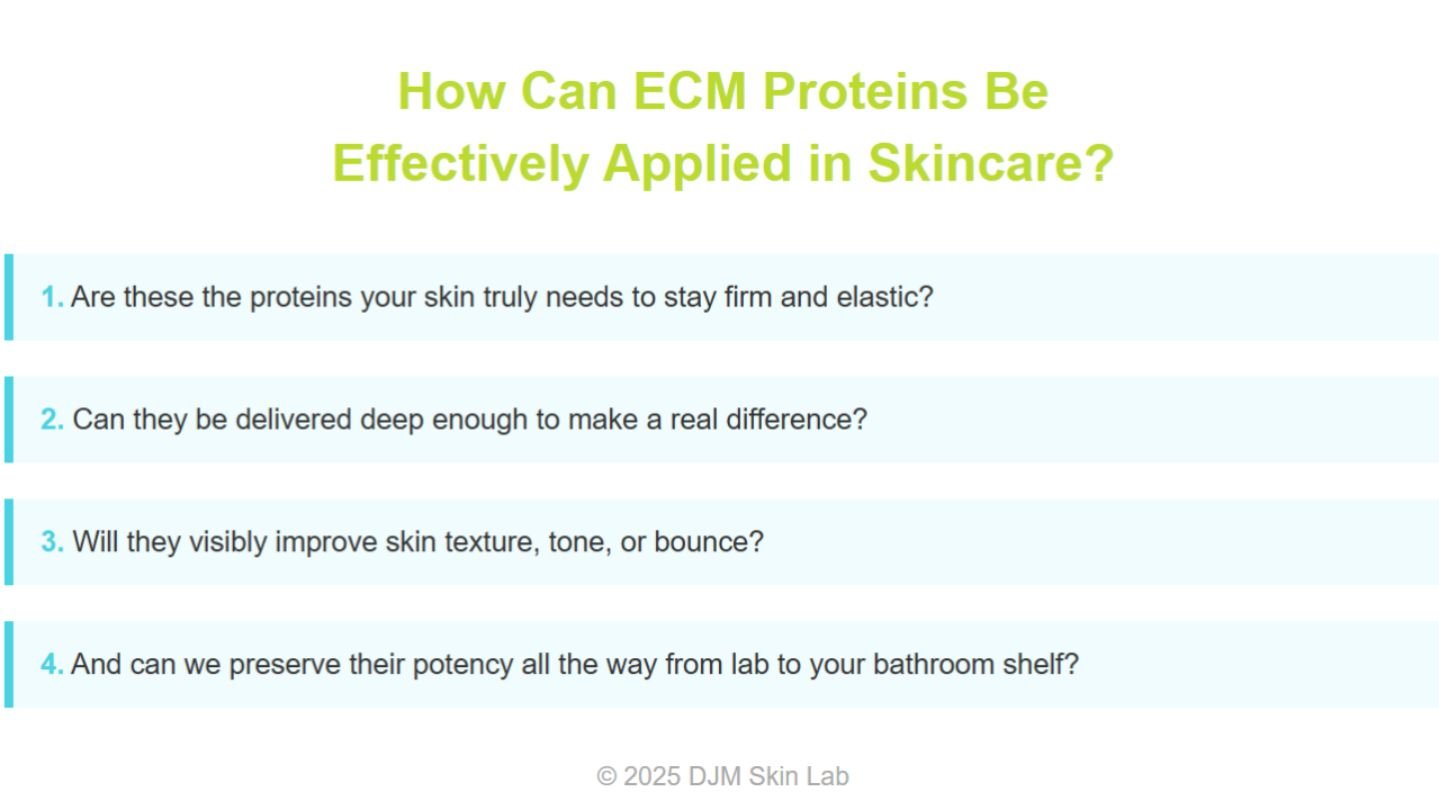What Is the ECM
The Extracellular Matrix (ECM) is a finely structured network made by our own cells and released into the space around them. It’s made up of essential proteins and sugars that work together to support the skin’s structure and health.
Key components include:
- Collagen – the protein that gives skin its firmness and strength
- Elastin – allows skin to stretch and bounce back
- Fibronectin – helps cells attach and repair
- Proteoglycans (including Hyaluronic Acid) – deeply hydrate and maintain skin’s plumpness
How Collagen Powers Youthful, Firm Skin
Collagen is a highly specialized family of fibrous proteins found throughout the animal kingdom and is the most abundant protein in the human body, making up approximately 25% to 30% of the total protein content. It is present in various organs and tissues but is most concentrated in connective tissues, where it forms the fundamental framework of the extracellular matrix (ECM).
Collagen is synthesized and secreted into the extracellular space by several cell types, including fibroblasts, chondrocytes, osteoblasts, and certain epithelial cells. This vital protein provides structural support and strength to tissues, playing a crucial role in maintaining skin firmness and resilience.
In adult skin, Type I collagen predominates, giving skin its strength and durability. In contrast, infant skin mainly contains Type III collagen, which is associated with skin elasticity and regeneration. As Type III collagen decreases with age, common signs of aging such as wrinkles and skin laxity become more apparent.
Understanding collagen’s central role helps us appreciate why maintaining its levels and function is key to healthy, youthful skin. Advances in skincare focus on supporting collagen production and preventing its degradation to combat visible aging effectively.
How Elastin Maintains Skin Elasticity and Firmness
Elastin primarily functions through elastic fibers to maintain the skin’s elasticity. In mature elastic fibers, elastin accounts for approximately 90%, while microfibrils serve as the structural framework to which elastin attaches.
Elastic fibers act like rubber bands, providing the skin with stretchability and flexibility. This elasticity allows the skin to stretch and fold without damage, playing a crucial role in supporting and preserving the skin’s firmness and resilience.
By maintaining the skin’s ability to bounce back after stretching, elastin helps keep skin tight, smooth, and youthful-looking. As we age, the amount and quality of elastin decrease, leading to sagging and wrinkles. Therefore, skincare products or treatments that support elastin production and protect elastic fibers are essential for maintaining healthy, elastic skin.
What Does Fibronectin Do?
Fibronectin is an important protein that helps skin cells stick together and move when needed. It connects with special receptors on the surface of cells called integrins, especially one named αvβ3. This connection helps blood platelets attach better and supports cells involved in cleaning and repairing the skin, like fibroblasts, to move and grow more effectively.
Fibronectin acts like a guide for fibroblast cells, helping them travel to areas that need repair. It also helps keep the cell’s internal structure stable, so cells can stick firmly and work properly. Together with another protein called type III collagen, fibronectin forms a web-like structure between cells, giving the skin strength and support.
Moreover, fibronectin encourages the growth of new blood vessels by helping the cells that line blood vessels (endothelial cells) move and form new networks. This brings more nutrients and oxygen to the skin, speeding up healing and regeneration.
In simple terms, fibronectin is like a “glue” and “navigator” for your skin cells. It helps them connect, move, and grow in the right places, which keeps your skin healthy, firm, and full of life.

